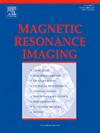Advanced diffusion-weighted imaging-derived quantitative parameters as biomarkers of fibrosarcoma-cell proliferation in nude mice: A study based on precise imaging-pathology correlation
IF 2
4区 医学
Q2 RADIOLOGY, NUCLEAR MEDICINE & MEDICAL IMAGING
引用次数: 0
Abstract
Purpose
To determine whether quantitative parameters derived using diffusion kurtosis imaging (DKI) and intravoxel incoherent motion (IVIM) imaging reflect pathological changes in fibrosarcoma.
Methods
Thirty nude mouse models of fibrosarcoma underwent T1/T2-weighted imaging, DKI, and IVIM imaging on a 3.0-T scanner. Immunohistochemistry was utilized for the hematoxylin and eosin, aquaporin 1 (AQP1), aquaporin 4 (AQP4), and Ki-67 staining of fibrosarcoma tissue, and AQP1 and AQP4 staining of normal muscle tissue (NMT). The independent-sample t-test was used to compare AQP1 and AQP4 expression in fibrosarcoma and NMT. Pearson and Spearman correlation analyses were conducted to evaluate the correlation between imaging parameters and pathological indicators. Multiple linear regression analysis was employed to identify the pathological indicators independently associated with quantitative DKI and IVIM parameters.
Results
Apparent diffusion coefficient (ADC), D, f, and mean kurtosis (MK) indicated cell density and Ki-67 and AQP1 expression intensity. D values reflected AQP4 expression intensity, while MD reflected cell density and AQP1 expression intensity. Cell density (CD) independently influenced ADC and f values, while CD and AQP1 independently influenced D values.
Conclusion
CD and Ki-67 independently influenced MK. DKI- and IVIM imaging-derived ADC, D, f, MD, and MK were correlated with AQP1, AQP4, Ki-67, and CD in nude mice with fibrosarcoma.
先进的扩散加权成像衍生定量参数作为裸鼠纤维肉瘤细胞增殖的生物标志物:基于精确成像病理相关性的研究
目的:探讨扩散峰度成像(DKI)和体素内非相干运动成像(IVIM)的定量参数能否反映纤维肉瘤的病理变化。方法:30只裸鼠纤维肉瘤模型在3.0 t扫描仪上进行T1/ t2加权成像、DKI和IVIM成像。免疫组化法对纤维肉瘤组织进行苏木精、伊红、水通道蛋白1 (AQP1)、水通道蛋白4 (AQP4)、Ki-67染色,对正常肌肉组织(NMT)进行AQP1、AQP4染色。采用独立样本t检验比较AQP1和AQP4在纤维肉瘤和NMT中的表达。采用Pearson和Spearman相关分析评价影像学参数与病理指标的相关性。采用多元线性回归分析确定与定量DKI和IVIM参数独立相关的病理指标。结果:表观扩散系数(ADC)、D、f和平均峰度(MK)反映细胞密度及Ki-67和AQP1的表达强度。D值反映AQP4表达强度,MD值反映细胞密度和AQP1表达强度。细胞密度(CD)独立影响ADC和f值,CD和AQP1独立影响D值。结论:CD和Ki-67独立影响MK, DKI-和IVIM成像衍生的ADC、D、f、MD和MK与纤维肉瘤裸鼠AQP1、AQP4、Ki-67和CD相关。
本文章由计算机程序翻译,如有差异,请以英文原文为准。
求助全文
约1分钟内获得全文
求助全文
来源期刊

Magnetic resonance imaging
医学-核医学
CiteScore
4.70
自引率
4.00%
发文量
194
审稿时长
83 days
期刊介绍:
Magnetic Resonance Imaging (MRI) is the first international multidisciplinary journal encompassing physical, life, and clinical science investigations as they relate to the development and use of magnetic resonance imaging. MRI is dedicated to both basic research, technological innovation and applications, providing a single forum for communication among radiologists, physicists, chemists, biochemists, biologists, engineers, internists, pathologists, physiologists, computer scientists, and mathematicians.
 求助内容:
求助内容: 应助结果提醒方式:
应助结果提醒方式:


